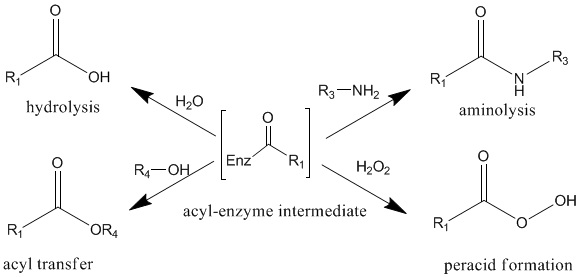Biocatalytic pathways to polyamides

| L.W.Schwab @ rug.nl | |
| Phone | +31 503636651 |
| Room number | 5118.0354a |
Introduction
In polymer chemistry, the use of enzymes as catalysts is relatively new. Enzymes are employed because they offer certain advantages over conventional catalysts. 1) catalysis under mild reaction conditions thereby saving energy in the process. 2) enzymes are highly enantio- regio- and stereoselective. Which saves the trouble of numerous protecting and deprotecting steps. With the use of enzyme catalysis it is possible to synthesize polymers that can not be obtained otherwise like polysaccharides.
Apart from polysaccharides, polyesters, polyanilines, polyphenols, vinyl polymers, polycarbonates and poly (amino acids) have been synthesized with enzyme catalysis. Remarkably polyamides do not appear in this list. This project focusses on the synthesis of polyamides by enzyme catalysis. Polyamides in a broad sense since peptide and poly(aminoacid) synthesis is also studied.

Choice of enzyme
Hydrolases are the class of enzymes we choose because of the general mechanism by which they operate. The hydrolysis of lipids (lipases) and proteins (proteases) proceeds through a so-called acyl-enzyme intermediate. This intermediate species can be attacked by a nucleophile. See picture.
When the intermediate is attacked by an amine nucleophile amide bonds are formed this is called aminolysis. Proteases can catalyse the aminolysis of amino acid esters. The lipases currently under investigation are Candida antarctica lipase A and B. The proteases used are a -chymotrypsin and papain. We are always on the lookout for new enzymes.
Substrates
All the enzymes employed catalyze the aminolysis of estergroups. The diesters used can be simple aliphatic diesters like dimethylsuccinate and dimethyladipate but also aminoacid esters or more complex like coupled aminoacidesters. The amines used are aliphatic diamines. Lactamrings as substrates are also under investigation.
| Last modified: | 01 July 2015 10.53 a.m. |
